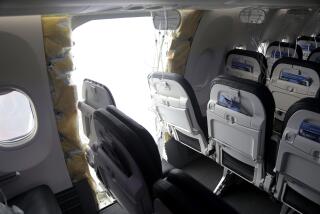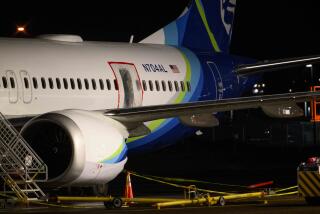737 troubles have Boeing reeling, but Seattle carries on
Almost half a century has passed since the “Boeing Bust,” when the company shed 60,000 jobs and a billboard declared, “Will the last person leaving Seattle — turn out the lights.”
Boeing neared bankruptcy, dragging the city with it. Unemployment hit 16% in 1971, the highest in any U.S. urban area since the Depression. Seattle became a poster child for perils faced by company towns.
Now the aerospace giant, reeling from the grounding of its 737 Max jets after two fatal crashes, is scrambling to right itself again. While the situation is dire — the company faces a grand jury investigation, lawsuits and reduced share prices — the outlook for the Seattle area, where the plane is made, is nowhere near as bad as decades ago.
Seattle is more resilient because it’s no longer a one-horse city after having been dependent in turn on timber giant Weyerhaeuser, Boeing and then Microsoft.
While it’s no longer true that, as an old saying goes, “When Boeing sneezes, Seattle catches cold,” Boeing remains a behemoth in Washington state, where the company has 66,000 workers and $55 billion in annual revenue.
As such, Boeing remains Washington state’s largest employer — although if Amazon’s hiring streak continues, the Seattle-based tech dynamo will soon overtake the aerospace giant.
Boeing engineers are scrambling to fix software thought responsible for crashes of a Lion Air flight in Indonesia that killed 189 people in October and an Ethiopian Airlines flight in March that killed 157. The accidents have undermined trust in the international aircraft certification system, in which foreign agencies routinely accepted findings of the Federal Aviation Administration. Even after the second crash, the FAA initially expressed confidence in the safety of the 737 Max while most nations suspended flights.
If agencies abroad insist on doing their own lengthy certifications or the 737 Max flunks FAA airworthiness standards, Boeing’s revenues could plummet.
“This has the potential to be an incredibly complex international mess,” said aerospace consultant Scott Hamilton, managing director of Leeham Co., near Seattle. He advises Boeing workers to save more of their paychecks and wait to buy cars and other big-ticket items.
For now, few appear to be heeding such warnings.
Renton, the city of 100,000 where Boeing makes the 737 Max, sits 11 miles southeast of central Seattle, the site of Amazon’s glitzy headquarters. Recent arrivals in Amazonia are often only dimly aware of Boeing’s presence in the region.
With every shift change, Renton workers stream into the hulking factory that employs about 12,000. Overtime was routine before the company announced April 5 that it would cut output of 737 Max planes from 52 a month to 42.
Renton car dealers say their business remains good as the company refrains from layoffs. Boeing employees pack the Pickled Onion, a favorite pub, for beer bingo, darts and pool.
Machinists union leaders, who recently won their members a midcontract pay raise amid a labor shortage, aren’t talking. Boeing has adopted a humble tone since the second crash, of the Ethiopian jetliner, on March 10.
“We’re focused on testing and implementing the software update, providing pilot training, and rebuilding trust with our airline customers and the traveling public,” said Paul Bergman, a Boeing spokesman.
In 1968, before the legendary bust, Boeing employed 1 in 5 of Seattle’s workers. But the company, which debuted the Boeing 747 in 1970, overestimated demand for the world’s first jumbo jet, setting the stage for its drastic fall.
Seattle became tagged as America’s “food stamp capital” in a 1971 congressional report. But as unions looked out for members, business and political leaders laid foundations that helped attract companies including Microsoft to the area, said Andrew Hedden, associate director of the University of Washington’s Harry Bridges Center for Labor Studies.
Hedden, researching a doctoral thesis on Seattle’s economic rebound, said laid-off blue-collar workers had the most trouble finding jobs after the bust. He expects that manufacturing workers would again take the brunt if Boeing takes another dive.
Hedden worries about the city’s increasing reliance on Amazon, given the tech industry’s boom-and-bust cycles. “Amazon’s footprint in the city is just enormous, and probably to the point where it’s not very safe,” he said.
The “wealth bomb” that Amazon has dropped on central Seattle — in the form of upscale offices, apartments, yoga studios and dog day-care lounges — distracts residents from Boeing’s troubles, said Jeff Shulman, whose “Seattle Growth Podcast” probes the city’s changes.
“Boeing does matter, and it would be problematic for certain areas of the region if it suffers,” Shulman said, “but that hasn’t reached the public consciousness on a broad scale.”
Boeing dealt Seattle a blow in 2001 by moving its corporate headquarters to Chicago, though much of its manufacturing operations remain. By then, however, Microsoft reigned supreme in the region that once depended on Weyerhaeuser and other timber and mining businesses.
Other cities, notably Detroit after the auto industry’s decline, have foundered after major companies waned, said Margaret O’Mara, a University of Washington history professor and author of a forthcoming book on the U.S. tech industry’s rise. Residents of Seattle, relishing its natural beauty and livability, have tended to stick around for second acts sparked by innovation, O’Mara said.
“Despite the fact that so much of the economy is often revolving around one company or sector,” she said, “the Seattle region keeps on going.”
Seattle takes a small step against gentrification »
More to Read
Start your day right
Sign up for Essential California for news, features and recommendations from the L.A. Times and beyond in your inbox six days a week.
You may occasionally receive promotional content from the Los Angeles Times.







